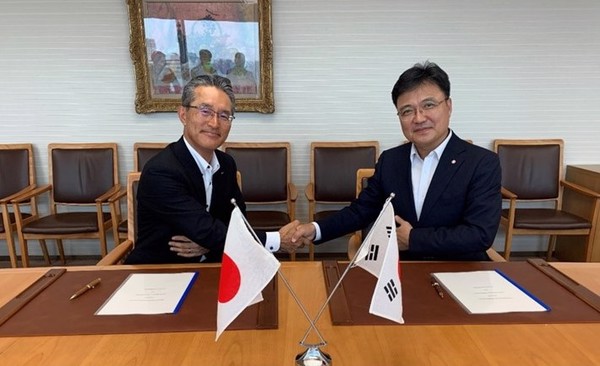Itochu partners hydrogen producer to scale ammonia supply chain in Japan, South Korea and beyond
Japanese conglomerate Itochu Corporation has teamed up with South Korean chemicals producer Lotte Chemical to create a supply chain for ammonia, and allow them to procure ammonia and other low- and zero-carbon fuels at competitive prices.
 PHOTO: Itochu Energy & Chemicals president Masaya Tanaka (left) and Lotte Basic Material president Hwang Jin-koo (right) signed a memorandum of understanding on 21 July 2022. Itochu
PHOTO: Itochu Energy & Chemicals president Masaya Tanaka (left) and Lotte Basic Material president Hwang Jin-koo (right) signed a memorandum of understanding on 21 July 2022. Itochu
Itochu views ammonia as fuel that can curb greenhouse gas emissions from ships and thermal plants. It wants to secure steady supply of ammonia and create an international supply chain for ammonia as a marine fuel and fertiliser.
Takeo Akamatsu of Itochu’s marine and aerospace division told an S&P Global summit last month that he expects ammonia to be available as a marine fuel soon. Itochu has been working with other companies to set up ammonia bunker supply in Singapore, and develop a ship with an ammonia-powered engine by 2026.
A main concern around ammonia as a marine fuel has been its toxicity and potential safety hazards. Itochu and more than a dozen other companies and organisations launched an ammonia safety study in April to come up with a framework for knowledge-sharing and guidelines.
Both Japan and South Korea will be big importers of ammonia and other low- and zero-carbon fuels in the years to come, Itochu and Lotte say.
Hydrogen and its ammonia derivative are set to play major parts in Japan’s long-term decarbonisation plan. The government of Japan forecasts that domestic ammonia demand will rise to 3 million mt by 2030 and then grow tenfold to 30 million mt in 2050.
Because ammonia is easier and cheaper to store than hydrogen it can be used as a hydrogen carrier. Hydrogen can be low- and zero-carbon either through electrolysis of water with renewable energy (green) or electrolysis of water with energy from fossil fuels with carbon capture and storage (blue).
Hydrogen can then be combined with nitrogen captured from atmospheric air to produce ammonia through the well-known Haber Bosch process.
Lotte has previously said it is South Korea’s largest producer of hydrogen as a by-product from its petrochemical plants in Daesan, Ulsan and Yeosu. And it has set its sights on developing hydrogen production technologies and distribution.
By the end of the decade, Lotte expects to have ramped up hydrogen production to 600,000 mt, of which 160,000 mt will be blue hydrogen and 440,000 mt green. To store and distribute the hydrogen it will mass produce 100,000 high-pressure hydrogen storage tanks by 2025, and quintuple this to 500,000 tanks by 2030.
Lotte expects to supply a total of 1.2 million mt of hydrogen by 2030, which will include its own production and sale and distribution of hydrogen from other producers.





